Cold War Reminisces Today
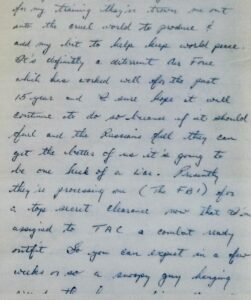
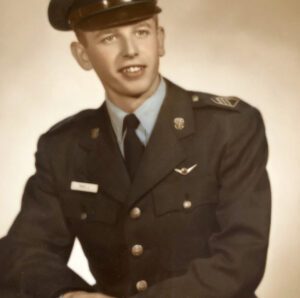
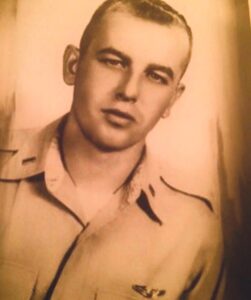




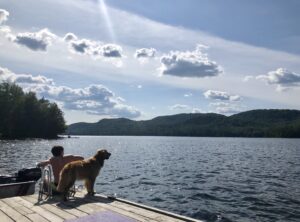
Author of Goodbye, Friend and The Souls of Animals, Gary Kowalski, suggests one might look to words to help heal from the death of a beloved person or pet. A minister, he writes, “I counsel those who are grieving to employ the power of words by writing a eulogy for the one they loved. The term itself means “good words,” for a eulogy attempts to sum up all the good qualities that made another person or pet memorable and worthy of our care, that reflects on traits that made the creature most endearing or stamped with a special personality.” As I often turn to my pen (usually my keyboard) to express my feelings, here goes:
Scout was our beloved five-year old Golden Retriever. There was something special about Scout. It wasn’t just his handsome looks, but his temperament and personality. Scout was gentle, mellow, kind, and goofy. He loved to love, and be loved.
Scout enjoyed curling up next to me on the couch as I read or wrote, and would often lay his head on my computer.
. 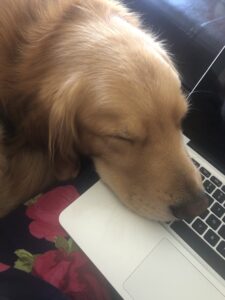
Other times he would sit or lay along the wall of the front porch near the door or under the shade of the Pear tree watching for the school bus or whoever was rounding the bend on the sidewalk across the street.
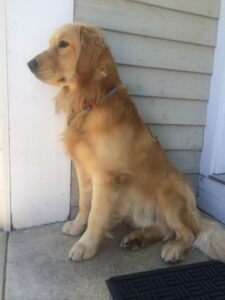
He also loved lying on the hardwood floor in the kitchen, with back legs flat out or up against the wall.
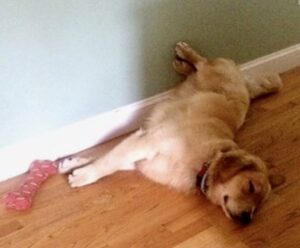
The staircase landing was a place Scout rested and watched from, too.
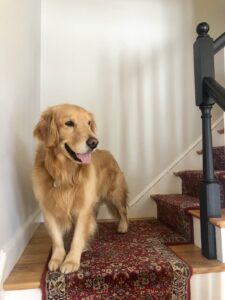
From there he could turn to a jump down the stairs and jangle of his collar to follow any or all three boys outside to play. Scout loved going in and out and probably enjoyed being outside most. He’d come in the back deck then soon ask to go out the front, often when he spotted a dog friend able to play on our front lawn.
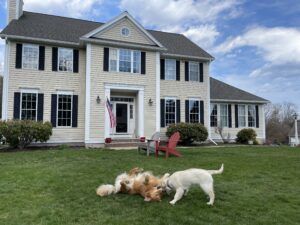
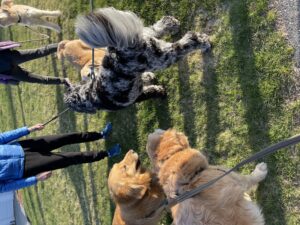
Other times in the family room he’d jump up in the air with the boys to cheer on the Patriots. In general, Scout was our fourth ‘boy.’ He most certainly was part of the family.
Scout arrived to us by some part fate. On August 28, 2015 we un-expectantly lost our 9 year-old Golden Retriever, Biscuit, to cancer of the blood vessels. He became sick and had to be put down the day before our oldest son, Ryan, was due at college freshman year. It felt so young to lose a dog yet ironically now I would give anything to have had four more years with Scout.
We thought we would wait one year to get another dog but when our youngest son, Andrew, cried himself to sleep each night I googled Golden Retriever breeders north of Boston. Several popped up. I was drawn to Pathfinder Golden Retrievers. Breeder Laura Bellochi’s website noted the business was named for her father, a military veteran. His job in wartime was to jump out of airplanes as a group of men followed. I liked that, a lot, and her dogs were beautiful, so I sent Laura an email. I stated our family grievance, explained why we love dogs, and how we came to choose Golden Retrievers (footnote at end). I also told her I appreciated her father’s service and that I was writing a military story based on my ancestors’ service.
Within days of sending the email, Laura and I spoke. We connected. She happened to be driving back from Pennsylvania where she had taken her female, Story, to be bred to a stud named Detour. Both names spoke to me, in regards to the letter I’d sent her and our family’s situation. She explained Story had a sweet, mellow temperament, had won “Best of Winners” at Westminster Dog Show that February 2015, and after her next litter would become a therapy dog.
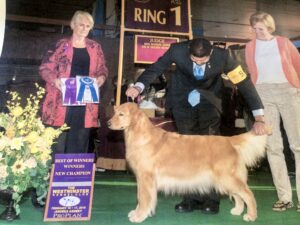 Story
Story
Detour
In a few days Laura learned Story was pregnant. We visited Story and her pups, when about six weeks old.
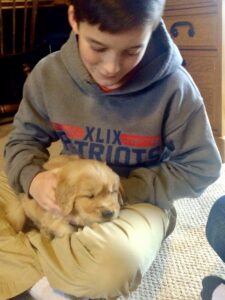
Andrew and Scout, week 6
Scout came home to us December 11, less than four months after Biscuit died.
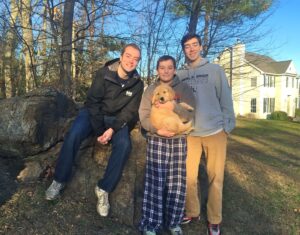
To be honest, it took me awhile to bond with Scout. When he was a puppy, for instance, I recall him pulling at the hem of my jeans until they tore. Wanting Biscuit back I cried. But soon I enjoyed watching Scout’s ‘firsts’ such as the sight of the ocean on a windy, cloudy day. I took him to Singing Beach in Manchester-by-the-Sea and the sight of the waves crashing in made Scout freeze. The wind and his fear flapped back his ears. But then, slowly, with my encouragement he inched his way to the shoreline. Scout and I grew to love our walks on the beach together where he was free to run and play with other dogs.
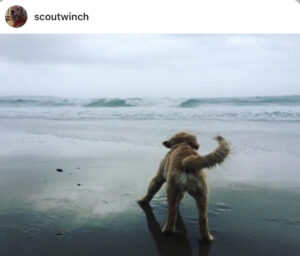
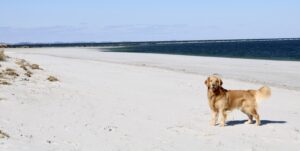

One of Scout’s favorite things was blankets’. Laura sent him home with a green and white one scented with Story and his litter mates. He slept with it and often wanted to take it outside. Knowing it might get lost I would ask for it at the door. “Leave it, Scout.” When he wouldn’t (@90% of the time) I would unclench his teeth and pry open his mouth for him to drop it. He not only loved that blanket (which we still have) but other ones. If any were folded or draped on the couch or a family member had one in their lap, he would sneak over and before we knew it the blanket was being dragged over the family room Berber carpet to his bed or a cozy spot. Scout would then lie down and with ease curl it up and create a perfect pillow to lay his head upon. It was so funny, and quite an art, really!
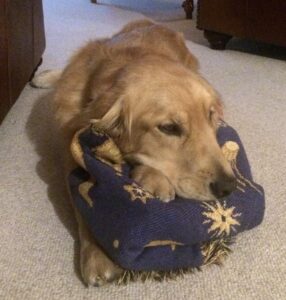 Blanket pillows created by Scout
Blanket pillows created by Scout
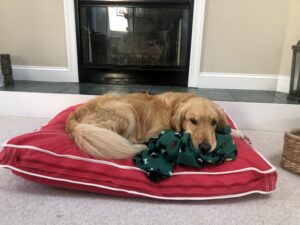
Like many retrievers Scout loved picking up and carrying shoes, usually from the front hall to the family room but bedrooms weren’t off limits. More mornings than not I would search for my L.L. Bean ‘Wicked Good’ slippers, walking down stairs with one on, one off, looking sleepily for the missing one before making coffee.
 Scout fortunately didn’t chew shoes but the family room was strewn with them and various blankets. We often joked it looked like a yard sale.
Scout fortunately didn’t chew shoes but the family room was strewn with them and various blankets. We often joked it looked like a yard sale.
Scout loved to sit on the ottoman in the family room where he could watch anything going on there but also in the kitchen.
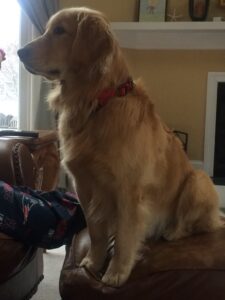
He also liked to ‘nudge’ us with his nose for attention (especially when we held electronic devises) but he rarely misbehaved, accept when something like this happened while we were away (laugh out loud):

Scout wanted to please, and he did. He didn’t beg for food but rather lay under the kitchen table or stools at our feet during mealtimes. As soon as we stood to clear plates, however, he would pop out, wondering if he might get something. He’d go to his bowl looking longingly at it then dart his eyes back to us. He loved a treat of chicken (his favorite) or steak that had been grilled. Being near the grill with Pete was a special time for the two and I know more often than not Pete sneaked Scout a piece of meat or cheese.
The other frequent past time for Scout and Pete occurred at the nearby trails and fields at Gordon College where we often walked. The two had a game in which Pete would hold up a lacrosse ball that he’d found near the stadium. Scout would freeze in position to run. When Pete’s arm released Scout would chase the ball with all his speed. Upon return, it was difficult for Scout to let go of it.
Near a steep embankment next to the stadium Scout discovered his keen scent. He could find a ball buried down that hill under leaves or snow and was so pleased with himself when he returned with one. In the woods beside the trail winding along the pond Scout loved racing and bounding about like a deer, back and forth, dodging trees, stumps, and other obstacles. We were amazed at his agility. It was beautiful to watch.
Scout enjoyed going on college tours with all three boys. We cherished those times with him.
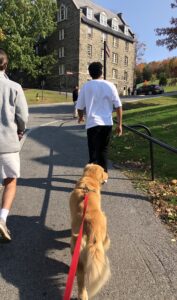 Campus Tour, Colgate University
Campus Tour, Colgate University
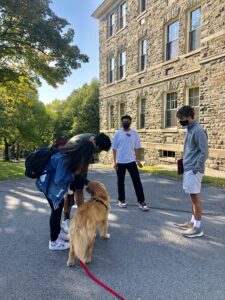
At Hamilton College Scout sat on the steps of the library surrounded by two students who petted him. He couldn’t have been any happier except when he gently stole a flip flop off one of the girls feet and they laughed. He wore the biggest grin!
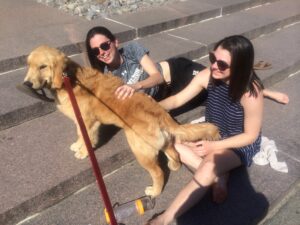
He visited Ryan and Alex at the colleges they attended.
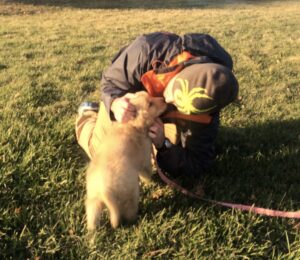
UVM, December 11, 2015 and January 2016 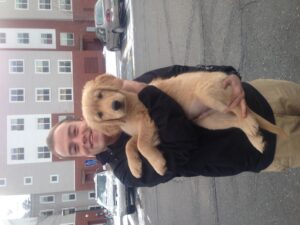
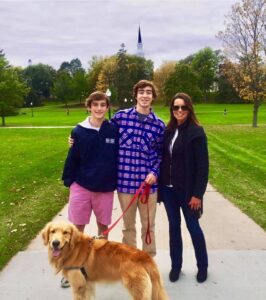 Middlebury College, Fall 2019
Middlebury College, Fall 2019
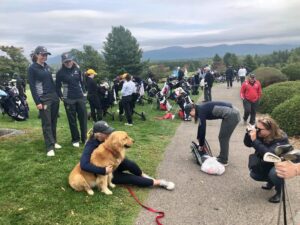
Making new friends, and in the spotlight. Middlebury College Golf Course
And Scout was beside Andrew when he learned he was accepted to his first choice college.
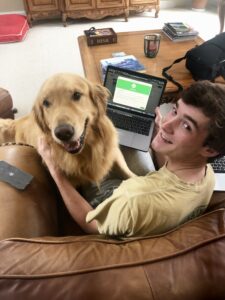
December 2020, upon acceptance to Hobart
Scout spent each of his four summers in the Adirondack Mountains on Big Moose Lake where he enjoyed the freedom of an unfenced yard, time with his human brothers, their cousins, and friends relaxing, hiking, swimming, and boating.
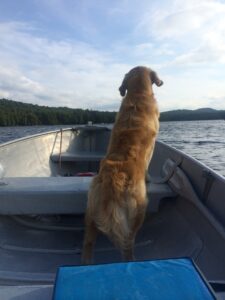

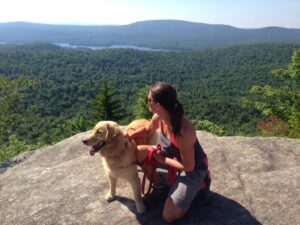 He also went to Martha’s Vineyard each summer
He also went to Martha’s Vineyard each summer
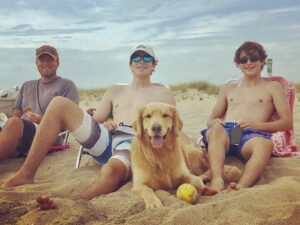
and various other places we traveled through the year such as Stowe, Vermont where we moved five weeks after Scout died.
 (Stowe, Thanksgiving 2020)
(Stowe, Thanksgiving 2020)
Scout comforted us as a family in times of need. He was by my side as I grieved the passing of my mother and all of us at different times when we needed love. He showed support in so many ways. He loved to snuggle!
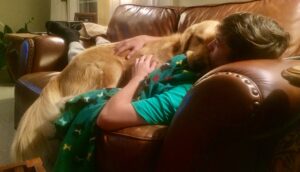
When Scout was a puppy Andrew (then age 13) lay on the kitchen floor on his back and urged Scout to sit on him. Scout would smile and Andrew would laugh.
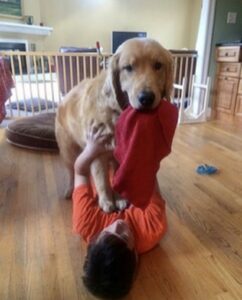

It made us all laugh and Scout knew it. It was silly and special and they did this almost every day, including the day Scout was euthanized. We were outside the front doors of Massachusetts Veterinary Hospital (due to Covid). Scout was almost too weak to hold up his head. IV and dialysis wires had been removed, but not the tight dialysis neck brace. Andrew lay down on the pavement and tried to help Scout onto him. Though Scout was too weak, he knew what Andrew tried to do. It was a deep act of love, and beautiful.
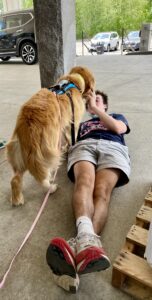
Upon learning of Scout’s sudden death someone who cared deeply for him looked at me in disbelief and with tears in her eyes, shook her head. “Scout was so smart,” she whispered. I believe she was right. Scout was intelligent. We believed he understood English and comprehended most things we talked about. He was respectful and understanding, too, when he interacted with dogs, puppies, or humans. He was a gentleman, so to speak.
I ‘pen’ these words four months after Scout’s passing and I still find it unfathomable he died at age five. Will I ever not? What is most difficult, for us, about Scout’s demise is that it was unnecessary. He was given a Lyme vaccination at the same time he had an active Lyme infection, which caused an overload of Lyme antibodies to attack his kidneys (Lyme Nephritis). In addition, when symptoms first began (two weeks before his death) there was failure to correctly diagnose Lyme which likely would have saved his life. Once a proper diagnoses was made (one week later) Scout was on life support and not even dialysis (a grueling six hour daily procedure) or a plasma exchange could save him.
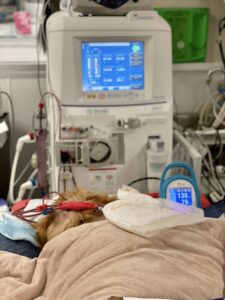
I wrestle with what I could have done differently, too, or what I missed.
There was much left for Scout to do and enjoy and for us to experience with him. He was our “bridge” to our new home in another state, as we became “empty nesters.” He never saw the house where he would have roamed on the countryside and experienced new things, like the sight and smell of cows, different bird species, and the view of the Worcester Mountain range in four seasons. He would have enjoyed the “Quiet Path” (where dogs and their walkers frequent), hikes, and greeting his brothers when they came home. We were all supposed to get older together.
It is heart breaking to know Scout is not coming back. His sudden passing is another indicator how fragile, uncertain, and sometimes unfair life is. None of us know what lies ahead, so we must enjoy today and the love we receive and give. I find some comfort in knowing Scout enjoyed his life and lived in love. I also find sharing his story with others helps, not only to keep his memory alive but to hear others’ stories. In doing so we have learned of similar situations and devastating losses, both pet and human, or both at the same time. But whatever the stories are (and they are never the same), they connect us and by connecting we support each other.
As my family turns a page to the next story Scout is still by our side. There has not been a day since May 23, 2021 that we have not thought of, talked about, or missed him. Each day I speak to him and ask for signs he is with us. Scout was such a good boy and is missed beyond any words or story can explain.
*
Four months after Scout’s passing our next “story” is an 8 week old female Golden Retriever born July 29 (same timeframe between bringing Scout home after Biscuit died). She is another “Pathfinder,” whose litter name is “Road Trip.” We have named her Ranger Scout Winch. Named Ranger because of a letter I received from a 91 year old friend who wrote me about Scout being sick. By the time I received it, Scout was gone. It read: “I am praying for Ranger.” The name spoke to me, for it means “Keeper of the countryside, a protector of a body of men,” which seemed to fit perfectly for our new home, the boys, and with Scout.
We brought Ranger home Sunday, September 26 and in the blur of the first week, between the “in and outs” every 20 minutes, night wakings, training accidents, teething, etc., there were periodic tears over Scout’s loss. The two of us asked, that week, “How has this happened? Why isn’t Scout here? Can we handle a puppy? We were just doing this five years ago…” But in two week’s time we have connected with Ranger, just like we did Scout after Biscuit. It doesn’t mean we don’t miss Scout any less or feel the sharp pain of his too early loss but Ranger redirects us.
The fact, too, that we see similarities in her to Scout gives us all comfort. The kind veterinarian who euthanized Scout said, “see you on the other side, Scout…” but perhaps we did not have had to wait that long. Either way, Scout was wonderful, is missed, and with us – always.
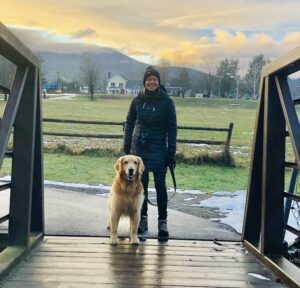
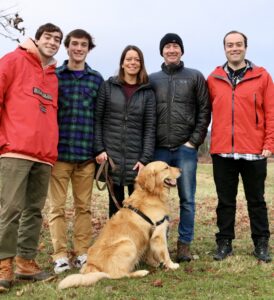
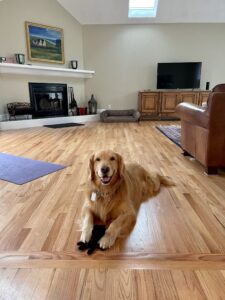
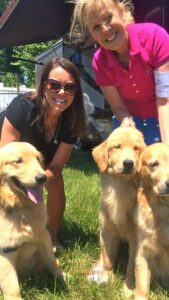 Laura Bellochi of Pathfinder Golden Retrievers and I with Scout, Story, and another Pathfinder. 2018
Laura Bellochi of Pathfinder Golden Retrievers and I with Scout, Story, and another Pathfinder. 2018
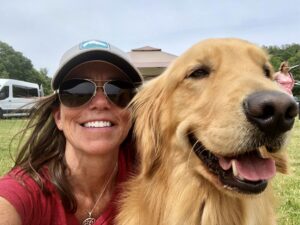
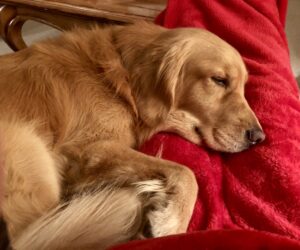
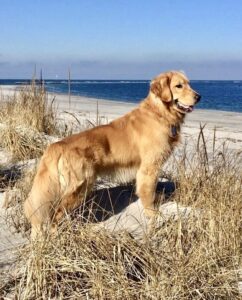
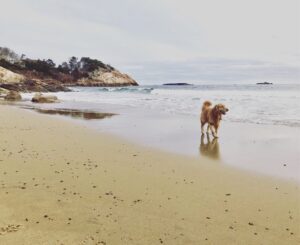
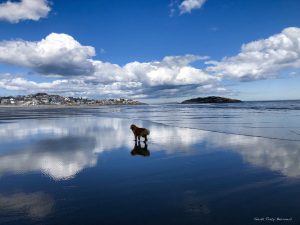
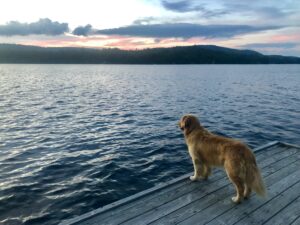
Big Moose Lake sunset, August 2020
Note: In the summer of 1970 at age three I fell in love with two Golden Retrievers (Sandy and Corn) that I spent each day with. For three years I asked my parents for a Golden Retriever puppy, finally writing my father a letter about it. He said my “P.S. Please say yes!” sealed the deal. In late 2015 I wrote a short story about that experience, losing Biscuit, and Scout coming into our lives. Titled Asking for a Puppy, it was published in 2016.
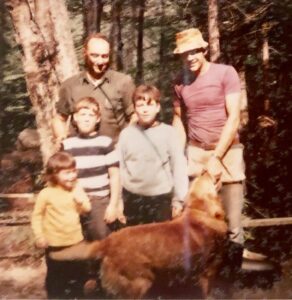
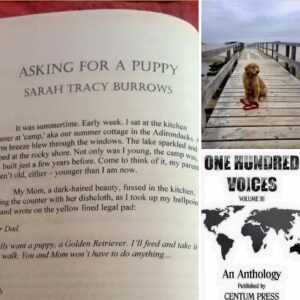
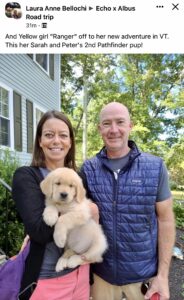
With Ranger, September 26, 2021
Posted on Categories BLOG, UncategorizedLeave a comment on A Eulogy to Scout (10/13/2015 – 5/23/2021)
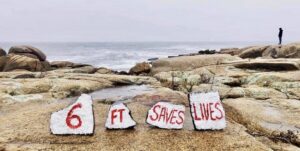
Sarah’s photograph “Looking Out” taken on Good Harbor Beach in Gloucester, Massachusetts on January 1, 2019 – was chosen for the 2020 Essex National Heritage Area website cover page. essexheritage.org
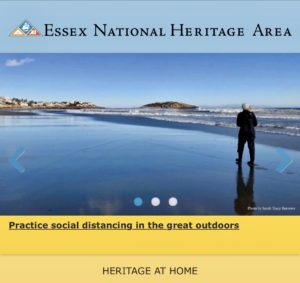
In addition, Sarah’s photograph “Heading to Play” was chosen as a 3rd Prize Winner in the 2019 National Essex Heritage Area photography contest in the category “People of Essex County.” Her photograph of the Essex River was one of 9 photographs that won in the NEHA 2019 Instagram contest.
Posted on Categories News, UncategorizedLeave a comment on Winner of the 2019 Essex National Heritage Area Website Photography, March 5, 2020On National Women’s Day, I reflected on the courage of women, in general, and in my ancestry, how each was, in their own way and circumstances, courageous and impactful.
As an example, in this note written by my great grandmother, Florida “Flo” Bayard Seay Tracy, to my mother, Ann, for her wedding, “GrannieTracy” passed along “something old” – a handkerchief belonging to my 4th great grandmother, making the fabric today @160+ years old – and asked my mother to one day give it to the next bride. The second note, also written to my mother, was from Grannie’s daughter, Ellen,(“Aunt Ellie”) both women who I knew and loved.
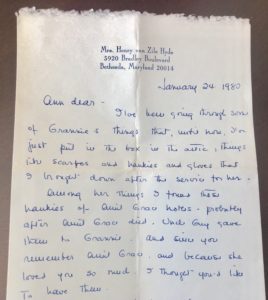
Their notes are reminders of the bonds women share and the courage, support, and love they can hold and spread, to themselves, families, communities, and generations following.
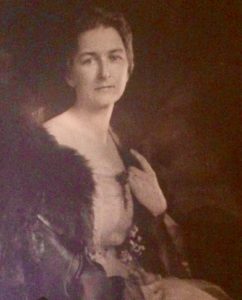
“Grannie Tracy,” born in 1880 in Rome, Georgia, was brave in many ways, one being to live outspokenly in a world she couldn’t hear. Though deaf since her early twenties, she communicated as well as anyone I knew. She read lips and spoke eloquently. She stated, jokingly, that she often learned more from a church sermon than people who could hear it. Her choice word, “darling,” and her gentile, graceful manner yet strong sense of feminism I can still hear and feel today.
Grannie Tracy was also brave when, after graduating from Shorter College in Rome, majoring and excelling in music, she called off her engagement to a local man to marry her true love, my great grandfather, James Grant Tracy, who she met at Cornell University while visiting a girl friend, a Cornell student. Eventually moving from her native Southern state, she settled with James in Syracuse, New York.
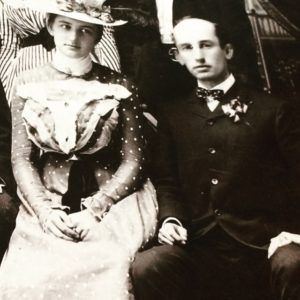
An outstanding writer, historian, and genealogist, who consistently and exhaustively tried getting her work published, her short stories speak vividly of her childhood as the daughter of Rome’s mayor (John Seay), owner of the Coosa River Boats Company, veteran of the Civil War (as were her two older brothers), and the strong woman who raised her. One of Flo’s stories explains the loss of the family’s largest boat, by flood, recalling her father’s discouragement upon returning home after learning the news but her mother’s resiliency springing into action to get him and the family right back on their feet.
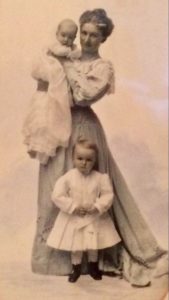
Ironically, years earlier, while Grannie’s father and brothers fought for the Confederacy, her future husband James’s father and uncle (Colonel Osgood Tracy and Confederate Medal of Honor recipient, Major William Tracy respectively, 122nd NYSV) fought for the Union, leaving at home their widowed mother, my 3rd great grandmother, Sarah Vose Osgood Tracy.
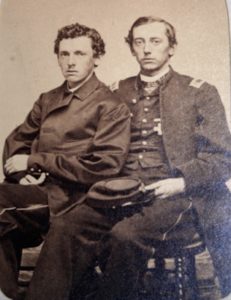
Grannie herself would one day see her youngest, son, Ted, serve in WWII, landing on Iwo Jima day two. No doubt Grannie kept these handkerchiefs close at hand during those years.
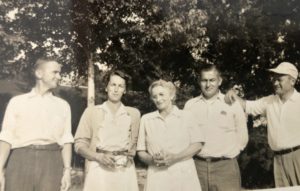
(Grannie Tracy, Aunt Ellie, Uncle Ted (left), Grandpa John Tracy and Uncle Osgood ‘Ots’)
After the death of her husband, Sarah raised four sons’ as a single parent, losing the youngest at age 6 to Diptheria, the same year James died. Sarah required James Jr., Osgood and Will to study and work hard, and they grew to be responsible, young men. Sarah was, as recalled in letters and her obituary, a conversationalist with a sharp memory and well liked by younger generations. Both an “outdoorswoman” and “excellent horsewoman,” at age 97, six weeks before her death, Sarah rode her two favorite horses some distance herself. Throughout her life, she was passionate about flowers, especially exotic European ones.
Sarah’s daughter-in-law, (my second great grandmother) Ellen “Nellie” Sedgwick Tracy – whose stepmother was Women’s Suffragist, author, and abolitionist, Deborah Gannett Sedgwick, of Boston – made an impact, too, in the lives of women.
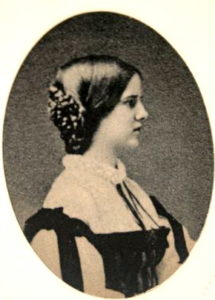 Nellie, age 21
Nellie, age 21
As her obituary states, she was “an original trustee of the Women’s and Children’s Hospital, later known as Syracuse Memorial. She was former president of the institution and became an Emeritus Trustee. In addition, she was head of the employment bureau at the Home for Aged Women.”
In her early twenties, she spent a great deal of time in Washington, engaging her interests in the abolition movement. Her father, two term N.Y. State Representative Charles Baldwin Sedgwick, was a staunch abolitionist, who refused to leave Congress until every slave in every state was free. (He was first to give a speech on the House floor in 1860 denouncing slavery, and years earlier represented white men whom freed from jail an enslaved runaway man who had been imprisoned). Though Nellie herself did not serve in Congress, as women were not allowed, she was alongside her father in the city, House and at the Naval Academy, for which he codified laws. She assisted the war effort in helping to raise funds for a new Navy vessel, the USS Onondaga. And on January 31, 1865, Nellie sat beside her father in the House when the Thirteenth Amendment to the United States Constitution passed in the House abolishing slavery and involuntary slavery.
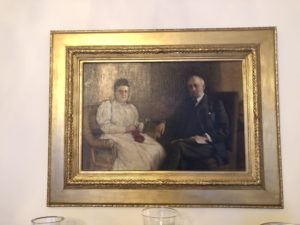
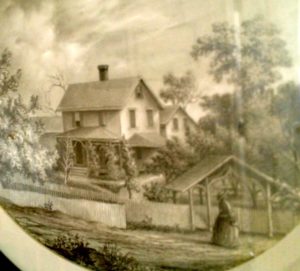
(Deborah ‘Dora’ Gannett Sedgwick, Sedgwick home, Syracuse, N.Y., 1860)
Circling back closer generations, my mother, Ann Livingston Tracy Burrows, the most important woman in my life who I will miss and honor each day I live, hopefully instilling the valuable lessons she taught me in my life and three sons’, was a teacher. She supported my father before he could practice law, and though not financially after that, in all ways until the day she died.
My father’s mother, Gertrude, my “Nan,” oversaw a maternity ward, delivering and taking care of babies at both the hospital and at home. She taught me at an early age to enjoy baking, and being a breast cancer survivor, that women sometimes must lose their breast(s) in order to save their lives.
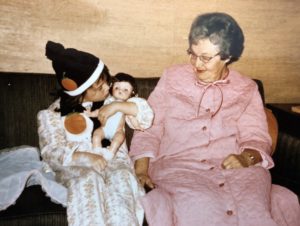
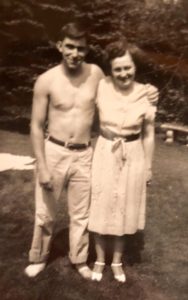
My maternal grandmother, Loretta, (below) I never had the chance to know, but I don’t doubt she was brave. She married Granny Tracy’s youngest and fourth child, John Bayard Tracy, and raised their three children during the Depression while my grandfather, who graduated from Cornell University, worked night shifts shoveling coal into furnaces at Crucible Steel and in time off and other periods, coffee into bags for the O.V. Tracy Coffee & Co. family business founded one generation before. My grandmother, mother, her brothers, cousins and friends helped, too, with the company.
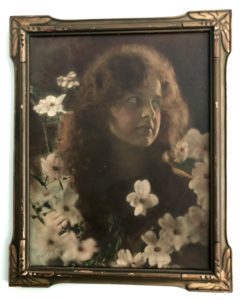 Loretta Tracy
Loretta Tracy
In 1962, during the Cold War, Loretta suffered a parent’s worst nightmare; her youngest child, “Johnny,” age 25, was killed while co-piloting a Secret Air Command mission back from Russia. After the Air Force messenger delivered a telegram to my grandparents’ front doorstep, I imagine these handkerchiefs were put to use all too well.
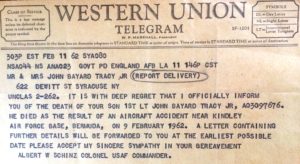
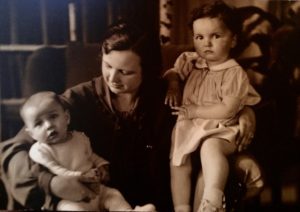
The loss must have been difficult, to say the least, on my mother, especially being 8 months pregnant (with my brother, John). And four and a half years after (17 months before I was born) at the age of 61, my grandmother died, after a battle with alcohol, which perhaps she thought might ease her pain. Though she lost that fight, in my eyes, she was a courageous and beautiful woman.
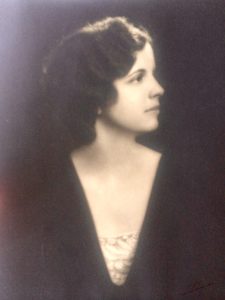
Loretta Tracy
The above stories are a small window into four generations’ of women in my family, colored like stain glass before me. I am grateful for the love, courage, and example these women passed on. I think often on the hardships and strength many of them must have had watching sons serve in wartime and the military.
I think, too, about the love I feel for women relatives today, such as my Aunt Barb, and Betty, my cousins, Dawn, Sharon, Whitney, and second cousins, Tracy and Julie, my four sister-in-laws, mother-in-law, four nieces, and my cousin’s wife, Toma, my mother and father’s cousins’ etc. still with us today. And those second aunts to me, sisters of my grandmothers’ and great grandmothers’ who were so wonderful in each of their own ways. I loved the gatherings we had.
I am grateful, as well, for women friends and neighbors, many of who are like family, and a woman who is like a second mother to me, Sue Beeching.
In closing, cheers to women everywhere who are “fighting the fight,” whatever battle and/or dream it is, trying to make a difference in themselves and others, and helping educate those following their lead.
Though my mother, grandmothers, great grandmothers and great aunts are no longer here on Earth they are and will always be women who are very much with me.
I dedicate this story to my beloved Grannie Tracy, Aunt Ellie, and my mother. I am grateful for the amazing women they were and the lessons theytaught. Granny Tracy is especially with me when I write. One day, I plan to publish her stories, for her, and of course, look forward to passing on the handkerchief!
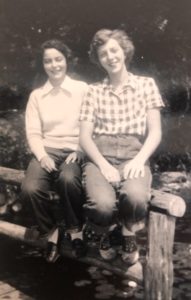
My mother with her best friend, The Waldheim Dock, Big Moose Lake
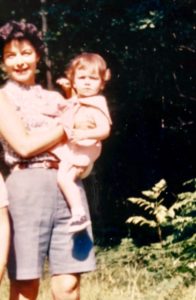
Mom and Me

Grannie in Europe w my grandfather
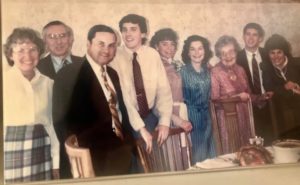
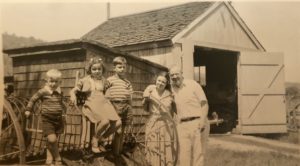
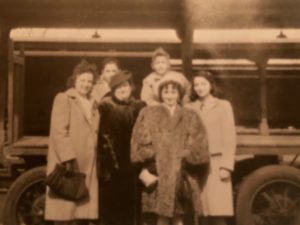
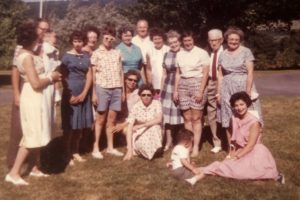
I am very pleased to have been elected and to assume the post as a trustee of The Leisler Institute, whose mission is to preserve the records of and promote the study of the early period of New York history between the period of the English takeover of New Netherland in 1664 and the American Revolution.
The nonprofit research and study center, devoted to Colonial New York under English rule as well as the permanent home of the Papers of the Jacob Leisler Project, serves scholars and students of this important 99 year period in our country’s history. The Institute is located in Hudson, New York.
I am a direct descendent of Jacob Leisler (8x granddaughter) through his daughter, Hester.

Sarah’s photograph, Walking on Clouds, was recently chosen for First Prize in the category, Off the Beaten Path, in the 2018 Essex National Heritage Photography Contest.
Her photograph, Church Steeple, was chosen out of 450 entrants as a winner in the 2018 Essex National Heritage Instagram Photography Contest.
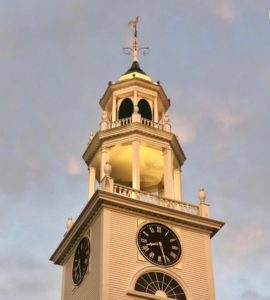
An awards ceremony and exhibit will take place on Wednesday, February 27, 2019 at 5:30 at Hunt’s Photo and Video in Melrose, Massachusetts, where her and the other 10 winning photographs will be displayed for one year, as well as at the National Park Service Visitor Center in Salem (2 New Liberty Street, Salem, MA 01970) and at the office of the Merrimack Valley Planning Commission (160 Main Street, Haverhill, MA 01830).
The contest was by presented in partnership with Hunt’s Photo & Video, the Merrimack Valley Planning Commission, and the National Park Service at Salem Maritime and Saugus Iron Works National Historic Sites.
Posted on Categories News, UncategorizedLeave a comment on Latest News, Photography
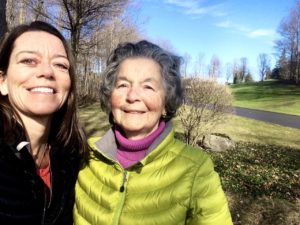
Dear Mom,
It sits here, framed, on my desk. The photograph of you and me; the selfie we took after our walk one year ago today – January 28, 2018 – snapped at the morning hour I write this.
It was a day much like today, in regards to weather, though it was warmer. The sun shone bright. There was no snow, surprising for a winter day in Syracuse, New York. It was nine days before you would experience a hemorrhagic stroke February 6 which would take your life nine days later on February 15.
I had been visiting you and Dad for several days. We’d had a special time – taking walks, visiting an abolitionist museum, sitting by the fire in the evening looking at photo albums, reading short stories that your grandmother wrote about growing up in Rome, Georgia in the late 1800s and you, Dad and I meeting your granddaughter, Alison, for dinner (1/27/18).
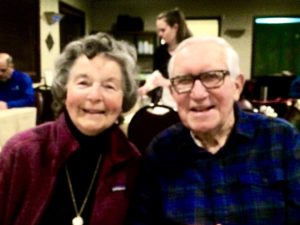 1
1
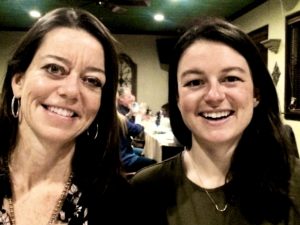
Four weeks before, you’d been here at our home for Christmas.
Standing in the driveway one year ago today after a walk that morning, at 11:37am and 45 seconds to be exact, we took this photo. It is the last walk and photograph the two of us we would take together, on a “normal” day. Afterward, we met for lunch longtime family friends, Sue and Tory Beeching- a mother daughter get together. In the parking lot before Sue and Tory and we went separate ways, I suggested a photo. A man happened to be walking by and offered to take it. Sue laughed, like she always likes to do.
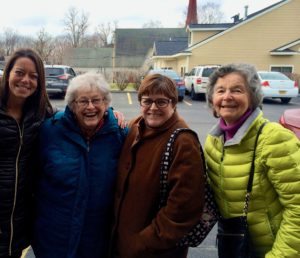
This would be the last photograph taken with her best friend, for the final hemorrhagic stroke you would experience would rob you of your speech, much of your mobility, and ultimately, on February 15, your life. I am therefore especially thankful for this photograph and of that beautiful, now extra special, time we shared together.
When I left that afternoon and drove up the hill, you waved goodbye from the driveway, like you always did. And, like I always did, I rolled down the window, looked back and beeped the horn. You were waving your arms as if you were doing jumping jacks, though your feet were planted on the ground. And you were smiling, sending me on my way with loads of love.
Looking back at this “year of firsts,” Mom, and now today – this “last normal day we spent one year ago” – it hasn’t been easy, to say the least, especially holidays and birthdays.
Valentine’s Day 2018 (the day before you passed)
Easter
Mother’s Day
Memorial Day
Father’s Day
Fourth of July
Labor Day
Dad’s birthday
Your Halloween birthday
Thanksgiving
Christmas
New Year’s…
But truthfully, every day is difficult and when February 16, 2019 – the first day of the second year without you – arrives, I can’t imagine there will be any day that we will miss you less. That is a testimony to the wonderful person you were; patient, kind, loving, forgiving, selfless, and supportive. Those characteristics are why we and so many others loved you dearly. You were a true “lady.” In every sense “genteel,” full of grace and class. You were special, Mom, and I your lucky daughter.
Nothing could have prepared me for your loss, not even when I knew you were going to die, because up until then you were still with us. But in our hearts, Mom, you have not, nor will you ever, die. You are with me and part of me each day, everywhere I go and in everything I do. I hear your sweet voice and constant encouragement. I imagine you saying, “it will be okay,” and that gives me strength. The love you gave and embodied continues to give me courage and always will.
These next few weeks – this end of “the first year” – will not be easy. I try to keep busy, continuing to write, research, learn, and photograph that which I find interesting, beautiful or important. I remind myself often that you told me you enjoyed looking at my photographs on Facebook.
Nearly 12 months later – one year minus 18 days – your passing still seems unfathomable to me. I will continue to think of and talk to you daily. I ache to hear you speak to and hug me again and it hurts more than words can ever express, knowing that you won’t, but I feel and know that I have your love with me each and every moment. And I believe you are watching over us and that one day we will be together again. Until then, know how much you are loved and so very much missed.
Love, Sarah
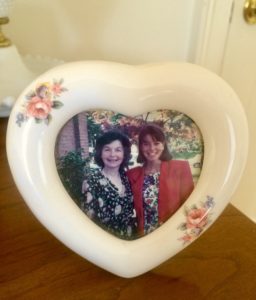
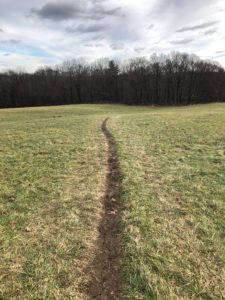
WALKING THE PATH
On a cold, clear, windy, late November day last week, I visited Andover, Massachusetts, where, during the ‘Great Delusion of 1692,’ forty-five women and men residents were accused of being ‘witches,’ arrested and imprisoned, including my 8th great grandmother, Mary Clements Osgood.
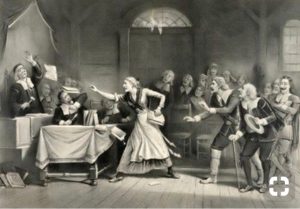
Mrs. Mary Clements Osgood, center
Since a young girl, I enjoy walking awhile in the paths my ancestors’, their friends, and ‘enemies’ traveled. Mary’s is certainly one, but I find many stories interesting, and connected – branching from one to the other.
With the aid of preserved letters, documents, photographs, paintings, and other historical information, I travel back in time, so to speak, acquiring knowledge about what they endured, enjoyed, where and how they lived, traveled, and whom they loved. In many ways, to me, learning about them is like doing a puzzle and playing a detective game. The end result – the prize – a window into the past, often colorful, like stained glass.
In Andover, more women and men were accused and arrested under the idea that they were ‘witches’ than in either the town or village of Salem, yet on that day, I didn’t go to Andover thinking of them or Mary. But as is often the case, one track led to another.
I was thinking of Mary’s husband, my 8th great grandfather, Captain John Osgood, born in Wherwell, Hampshire, England in 1631. At age 7 in April 1638, John sailed to America with his father (also named John), mother, Sarah Ann Booth (Osgood), and younger sister, Mary, on the ship, Confidence, landing in Ipswich during the month of June. After a quick stay there with emigrant (1633) and relative, Christopher Osgood, John settled his family for three years in Newbury until he moved them to a settlement called Cochichowicke (Great Water) which he named Andover, for his home town marketplace ‘across the pond.’
John Osgood built his home on the banks of the river, today at the junction of Osgood and Court Streets. He came to own 600+ acres of land, in what now is North Andover. His barn, on the east side of Osgood Street, still stands, along with his second home, on the National Register of Historic Places.
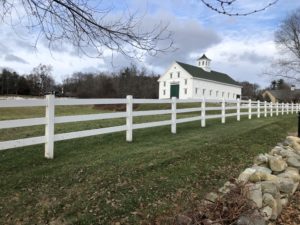
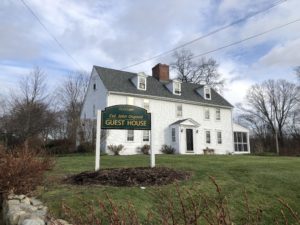
Surrounding both is land he called “Great Wide Meadow,” as referred to in 1690s’ deeds, including a long, sweeping hill then called ‘Weir Hill’ with views of the valley and lake. Of recent, the hill is named Osgood Hill, now public paths and wooded areas for the public to enjoy and roam. Edgewood, An Independent and Life Care Community, sits on 100 acres of John’s original land (including John’s original 1600’s barn and original house, now a guest house for visiting families) with Osgood first names marking street signs and mailboxes.
Finding out about John, I then wanted to know more about Mary. Born in Ansley, Warwickshire, England in 1637, her father was Reverend Robert Clements, a prosperous English wine merchant living at Croft, near Leicester city. During the 1620s and 1630s, Clements owned a fleet of ships which sailed between North America and England. During a shipwreck, his brother, John, lost his life.
When Mary’s mother, Lydia, died in March 1641, when Mary was four, her oldest brother, Job, seems to have traveled to New England, and along with ten others, settled Haverhill, Massachusetts. He soon asked their father to sell his English estate and join him. Clements did, emigrating with four of his eight children, leaving Mary, the youngest, in England, perhaps with grandparents, and two sons fighting in the English Civil War (they would eventually earn land grants and live in Ireland). At about 5 years of age, Mary re-joined her father, in New England.
Reverend Clements remarried in 1645, in Haverhill and on November 15, 1653, in the same town, performed the marriage ceremony of Mary and the young Captain John Osgood, age 20. Mary was 16.
While John volunteered service to the militia (30 years total), helped found North Parish Church, and became the first representative to the General Court of Andover, Mary gave birth to twelve babies (yes, twelve!). The couple buried two within the first year of birth, another two within a year and a half, the twelfth and last, just a month old, when Mary was about 54 years old. Eleven years later, in regards to that dark period of time in Mary’s life – the loss of her baby at age 54 – Mary would be accused by rivals of having performed ‘witchcraft.’
At age 65, along with fellow neighbors and friends, Mary was “examined” in Salem before John Hawthorne and other “Majestie’s Justices.” On September 8, 1692, after being “brow beaten,” Mary confessed to the incident below and indicted in January 1693. Recanting before Increase Mather, a powerful Puritan clergyman and president of Harvard College, Mary was imprisoned in Salem.
From the Salem Witch Trials Documentary Archives and Transcriptions:
The examination and confession (8. Sept. 92.) of Mary Osgood , wife of Captain Osgood of Andover, taken before John Hawthorne and other their Majesties justices:
She confesses, that about 11 years ago, when she was in a melancholy state and condition, (following the birth of her last child) she used to walk abroad in her orchard; and upon a certain time, she saw the appearance of a cat, at the end of the house, which yet she thought was a real cat. However, at that time, it diverted her from praying to God, and instead thereof she prayed to the devil; about which time she made a covenant with the devil, who, as a black man, came to her and presented her a book, upon which she laid her finger and that left a red spot…
Rev. Increase Mather’s Report of his Conversation in Prison with Mary Clements Osgood:
Being asked why Mary prefixed a time, and spake of her being baptized in The Great Pond, &c., about twelve years since, she replied and said, that, they asked the time, to which she answered that she knew not the time. But, being told that she did know the time, and must tell the time, and the like, she considered that about twelve years before (when she had her last child) she had a fit of sickness, and was melancholy; and so thought that that time might be as proper a time to mention as any, and accordingly did prefix the said time.
Being asked about the cat, in the shape of which she had confessed that the Devil had appeared to her, &c., she replied, that, being told that the Devil had appeared to her, and must needs appear to her, &c. (she being a witch), she at length did own that the Devil had appeared to her; and, being pressed to say in what creature’s shape he appeared, she at length did say that it was in the shape of a cat. Remembering that, some time before her being apprehended, as she went out at her door, she saw a cat, &c.; not as though she any whit suspected the said cat to be the Devil, in the day of it, but because some creature she must mention, and this came into her mind at that time.
“Stripings” of many, death awaiting execution, and the public hangings of approximately twenty women took place over a period of time. In regards to those from Andover, three persons were hung and one woman died before execution. Many of the girls, women, and men (mainly women, yet one girl as young as 4, who was executed) were accused of having “fits,” unable to control their muscles, privately and in public. Since the 1970s those ‘fits’ have believed, by some, to have been hallucinations caused by the ingestion of a common grain, poisoned naturally with a fungus; ‘ergot poisoning’ having effects much like that of LSD.
After some time, Mr. Dudley Bradstreet, Andover’s Chief Justice, who had issued the warrants and arrest of forty-eight suspected “witches,” finally refused any more. Bradstreet petitioned for the release of Mary and others (after which and for, he and his wife were themselves accused of being ‘witches,’ and fled North Andover for their lives). After four-six months in prison in Salem, Mary was released, with four other women. Bradstreet had, for all his weaknesses previously, saved them.
Learning more of Mary’s story, I contemplate her admittance that she experienced ‘melancholy’ after the birth of a child. Today this most certainly would be understood and accepted as postpartum depression, thought by many doctors to be caused by a copper overload. Sympathizing with Mary has made me appreciate and better understand the time she lived and imagine what she went through.
One of Mary and John’s children – my 7x great grandfather – Lieutenant John Osgood, born 1654, also spent time in prison. Active in the militia, an inn holder and serving frequently as selectman, he was popular among the townspeople of Andover, mainly due to his opposition of England taxes. He was imprisoned in August or September 1687, five years before Mary was accused of being a witch. Mary and John eventually left him their house, where the first recorded town meeting was held in March 1656.
In previous visits to North Andover, I have seen that house (today the guest house at Edgewood). I have also driven by the historical home at 440 Osgood Street, that of Samuel Osgood, who, three generations after Mary and John, was an American Revolutionary War colonel, First United States Postmaster General, and member of Continental Congress. His home housed Harvard’s library during the war against England.
A new house I discovered, however, upon this visit to Andover, after being given the address by the Executive Director at the North Andover Historical Society, was the address of my 5th great grandfather’s house, numbered 815 Osgood Street. I found the colonial – about a mile from the Colonel John Osgood House. Red in color, a sign to the left of the doorway read “Dr. Joseph Osgood, 1752.” (His father, my 6th gg, another John Osgood, born 1683, Deacon and Lieutenant of Militia, his wife, Hannah Ayres (Osgood) of Haverhill, born 1662).
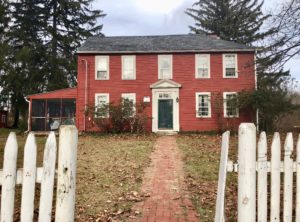
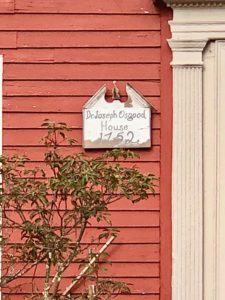
I parked my car in front of the white picket fence, in need of painting, and got out, to stand before the open gate leading up the brick walk to the front door. Though I was disappointed at the unkempt condition of it, being in its presence for the first time felt very special.
I envisioned my 3rd great grandmother, Sarah Vose Osgood (Tracy) – Dr. Joseph Osgood and wife Margaret’s youngest grandchild – born April 1804, running up the path to the door, anxious to greet her grandparents, and they her. Perhaps, after they opened the door, they bent down and wrapped their arms about her as they picked her up to a hug, with the aroma of a Sunday supper wafting from the kitchen fire.
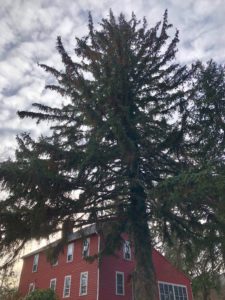
Sarah’s photograph and diary of 1862 were thankfully preserved. Sarah’s father – my 4th great grandfather – George Osgood, was also a doctor, like his father, whose house I now stood in front of, had been. Her mother, Sarah Vose, daughter of Colonel Joseph Vose of the 1st Massachusetts Regiment who fought alongside George Washington during the American Revolution, was born in Milton. She’d had a baby at 42 years of age and died when Sarah was eight years old, at age 50 of tuberculosis, or “consumption.”
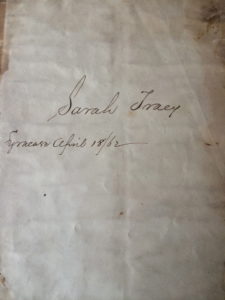
Standing there at Dr. Joseph Osgood’s house, I had just exited my warm car but not having worn a warm enough jacket, shivered. I contemplated what life must have been like, in the early 1800s. Considering a fall, winter, or spring day and night, and New England weather, the house inside would have have been cold – very cold.
The family would have gathered around the one fireplace – talking, reading, studying, playing music, etc. Babies would have been born in the bedrooms and died there, too. Without antibiotics, children often died of diptheria.
Joseph and Margaret, like Mary and John, and so many couples, lost numerous children, specifically they lost three sons, age @two and one age 14 ten months, the graves of which I would later see that day. Losing all those children might have been enough to kill my 5th great grand mother (or make her, like Mary Clements Osgood, delusional) but Margaret lived until 1797, to age 78. Fortunately, the third child, born in 1754, another John Osgood, would live to see adulthood and old age.
Remnants of what might have been the outhouse was a helpful reminder that there had been no running water and of course, no electricity. I considered what the Osgood father and son doctors must have seen in their lifetimes, practicing generalized medicine in the late 18th and early 19th centuries. They would have visited most homes in town, to doctor babies, children, women, and men for all different reasons.
Suddenly, bringing me back to the present, was the current owner or renter exiting the back door to his parked car in the driveway. I soon got back in my car but sat a time thinking about how my 3rd great grandmother, Sarah Vose Osgood Tracy, lived in North Andover until her later twenties when she moved to Syracuse, New York.
Sarah left the only home she’d known with her older half sister, Elizabeth Osgood (Putnam) and Elizabeth’s husband, Captain Hiram Putnam of Salem who had been commissioned by the wealthy Boston merchant, Joseph Peabody, to captain ‘The China’ twice around the world trading coffee, tea and spices. He later wrote he felt “ready to get away from the sea.” Ironically, Hiram’s male Putnam ancestors, of Salem, and the Peabody’s, were lead accusers in the witch craft movement.
Though Sarah moved away, during her 97 years of life she often reminisced upon her beloved North Andover. Suggesting that, along with many preserved letters, is a poem, below, written for her 93rd birthday by her nephew, George Osgood, giving insight into the beauty of the land and the love the Osgood generations held for it.
After leaving Massachusetts and arriving in Albany, Sarah met her love, James Grant Tracy, whose father, Captain Jared Tracy of Norwich, CT, was a commissary during the siege of Boston and later fought the enemy at sea. Sarah and James married and resided in Syracuse, where they lived the rest of their lives, though Sarah as a widow when their oldest son, James Grant, was 13.
This part of Sarah’s story I am familiar, for I have been engrossed in it my entire life, through letters, stories and memorabilia which my maternal grandfather, John Bayard Tracy, shared with me while I was growing up in Syracuse, in Sedgwick Farm. As a single parent, Sarah raised four sons, losing the youngest to diptheria within the same year of her husband’s death. Two of her remaining three sons’, Osgood and William, volunteered to fight in the American Civil War.
In Syracuse, I knew Osgood’s daughter-in-law, my great grandmother, Florida Bayard Tracy, who lived until I was ten years old. For that reason, to me, as a young girl, the past didn’t seem so long ago. I was amazed that I knew “Granny Tracy” whose father-in-law had fought in the Civil War for the North and father, Captain John Seay, and two bothers from Rome, Georgia for the Confederates, then some 110 years before.
At present, I understand better what my grandfather once shared and documents and books indicate. Having lived in Boston now more than half my life – the last 15 years on the North Shore of Boston, a 35-minute drive to Andover and 15 minute drive to where the Confidence arrived in Ipswich with my Osgood emigrant ancestors -it is part of my journey in adding to the puzzle, walking on and extending the path.
Ironically, twenty-five years ago, while living in Boston, I chose Andover to shop for and purchase my wedding dress, with my mother by my side. I chose it knowing our family history there, but not to the extent I know now or appreciate. While standing there last week in front of my 5th great grandfather’s house, I felt full circle – my past tied to my present, and future.
*
When I got back in my car, I cranked up the heat, put the car in drive and headed down Osgood Street, about 1/4 mile. I turned left, winding up a steep hill into the Steven’s Estate at Osgood Hill. At different times during the 1700 and 1800s, Osgood’s and Steven’s married. The red brick mansion and grounds are now owned by the Town of N. Andover, used for special functions.
Proceeding at the top, by the house, designed by prominent Boston architects and built in 1886 for Moses T. Stevens, an American textile manufacturer and a U.S. Representative from Massachusetts, I parked at the carriage house.
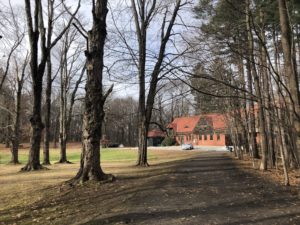
Heading to the trailhead of Osgood Hill, paths extend in three different directions.
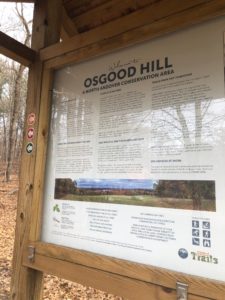
I first walked to the right, to a private drive, at the end of which might sit Sarah’s childhood home, now a private home, with magnificent views overlooking “The Great Meadow” and beyond, to the Colonel John Osgood Guest House and original barn, and Edgewood.
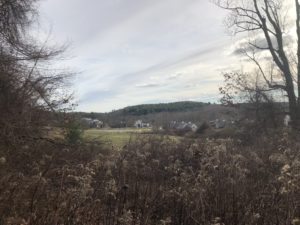
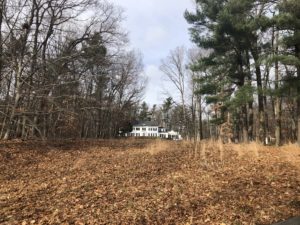
Walking back to the trailhead, I then took the path to the left, wrapping around Osgood Hill at its lower point. With woods on either side of the Hill, it reached the East side, with views extending through down the valley to Lake Cochichewick, which the Osgood’s called “The Great Pond.”
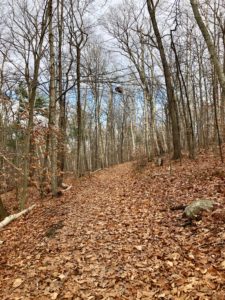
Among this path, where generations of Osgood’s roamed, Mary Clements Osgood, accused of and stating under duress, spent time, including that which when she was, as she stated in trial, ‘re-baptized by Satan,’ in its’ water with her friends. I couldn’t help but wonder whether, on a warm, late spring or summer day, Mary and/or they were just having fun, like I might today with my friends and neighbors.
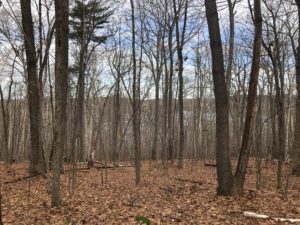
Perhaps a young man joined them, a man Mary described as a “Black Man,” and during trial, under verbal and physical abuse by the “Justices” at Salem, she referred to him as “Satan.” Mary’s great grandfather, less than a hundred years later, would allow African Americans and women as members of North Parish Church long before other New England churches did, and 80 years after that the Osgood Tracy brothers would go to war to end slavery…
With the majority of the leaves off the trees, a clear view presented through to Lake Cochichewick, “The Great Pond.” White birch trees and Oaks interspersed the woods, standing and covering the ground, causing a lightness and brightness to the dense forest. Original stone walls ran from the top of the Hill from the original estate, now private (at the end of the private drive I’d walked from the first path, perhaps the very house in which Sarah spent her childhood, yet another stone to turn) down toward the lake.
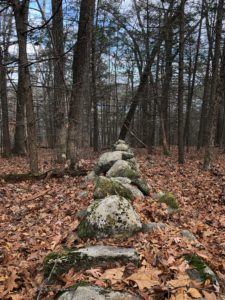
After a ten minute walk, the path opened to the wide lawn of green grass, to Osgood Hill (once Weir Hill) and a breathtaking view of sky and tree line. In my opinion, whether intertwined to this property through ancestors or not, you can not help to take in its natural beauty and feel connection to the land.

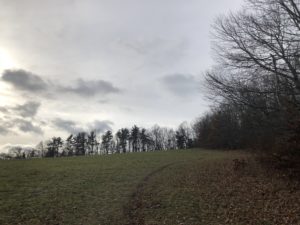
The wind rattled the dry leaves still clinging to the branches. Hawks circled overhead. Though it was my second walk on Osgood Hill ever, and the second time within this year, it felt more special even than the first. I felt closer to the past, like it was swirling with the brisk air.
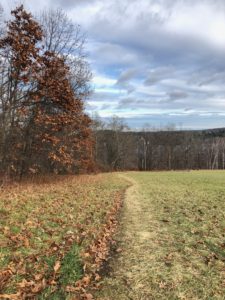
I followed the worn path amongst the green grass and reached the top of Osgood Hill, looking back from where I came. I took in the panoramic views. The lake in the distance sparkled in the sun, shooting through the clouds. The white birch trees stood at its shore’s edge, mixed among the others, the grass on the Hill was still green, with small patches of snow here and there, and the sky spread to the horizon.

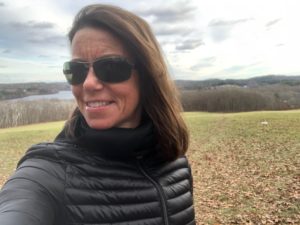
When it was time to go, I followed path markers into the woods at the top of the hill, at its’ highest point, enjoying the quiet of the woods, imagining, generations ago, my ancestors walking right there too.
But as the path became less marked, which would connect to the trail below, and being alone, I decided to head the way I arrived, down the hilly meadow, to circle the lower path, just above the lake.

Back to the Steven’s Estate and at my car, I drove out back down hill, to Osgood Street and headed to the First Burial Ground in N. Andover, in “The Great Meadow.”
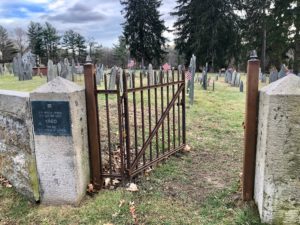
I entered the wrought iron gate just as a school bus about a 1/4 mile away dropped middle grade or elementary students off, with the sound of the children laughing and happy to be dismissed. As I stood by the Osgood gravestones, the boys, wearing their backpacks, were soon hopping over the stone wall, cutting through the old, historic cemetery. I imagine, from the surprise of them seeing me, that it is a daily occurrence, one which I found beautiful and touching – the incongruence of life and death connecting, and a reminder that life goes on.
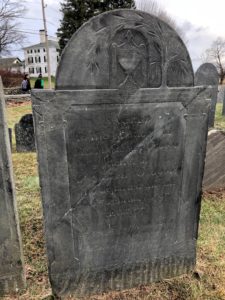
I would say, in ending, that I now certainly have a better understanding of the terrible injustices of, mass hysteria and cruelty, and broad area besides Salem affected by the witchcraft movement, reminded of what I learned in middle or high school that I had forgotten. I look forward to researching.
And in looking back at these numerous past generations, I am humbled by the experience. What I have discovered this past week and over the years, is that life, though different then and always changing, was still similar in so many ways and perhaps will always be.
Walking awhile in my ancestors, their friends and neighbors footsteps helps me to find and appreciate my own, and others. It not only shapes me, but inspires me, and in general, keeps me learning. It gives me a sense of who I am, who came before me, and what I want to accomplish.
Through the process and in life in general, I have found that some paths are smooth, others rough, some unmarked, many not straight. These stories above, and others, attest, paths can swerve. Change. End. And during our journey on the path of life, many people and places guide us, offering or giving direction, especially in our early years. When children, we often do not have the option of following which path we might choose for ourselves. As we grow older, we have more power of choice, though often time and/or commitments keep us going in one direction, often as if with blinders on.
Yet at any given point, new paths might branch off, and in changing direction, for want or not, we may find, that along with the path, our very selves and souls widen too.

Poem for Sarah Vose Osgood Tracy, written in 1897 for her birthday by her nephew, George Osgood:
A noble, Syracusan dame,
Whose years are only ninety-three,
The distant home from whence she came,
Today, in thought, would truly see.
As she in memory wanders back
Through pleasant scenes of long ago,
She views her native Merrimack
By hills and valleys grandly flow.
Again she trips with girlhood’s feet
Along the bank of vernal green,
Where, with the broader river, meet
The waters of the fair Shawsheen.
The Pond among its groves and hills,
Beneath the radiant sunset sky,
Again her heart with rapture thrills,
While joy and gladness light her eye.
The “China” down by Salem shore,
With sails all spread, she still would see,
Which long through calm and tempest bore
The hero noble, brave and free.
The hero left the ocean tide
With those whose lives her own endear;
And lived by Onondaga’s side
For many a long and happy year.
O what romantic feelings wake,
As she delighted rides away,
By wild Oneida’s lovely lake,
To spend her sweetest, happiest day.
Though she may love to muse awhile
On scenes where she delights to roam,
She better loves the gentle smile
Of one who cheered and blest her home.
The father and the little child
Must sweet remembrance bring today,
As they in love and beauty smiled,
Ere from the earth they passed away.
Her loved ones who have gone before,
A down the valley, dark as night,
Will gladly find the other shore
Aglow with heaven’s unclouded light.
The boys’ who bravely left her side
When bugle notes were loud and clear,
Through the sad fields of war to ride,
Today are grouped beside her here.
These sons will guard with tender care
The home of gladness, peace and love;
And seek by earnest thought and prayer
A brighter, happier home above.
George Osgood
Kensington, NH
April 1897
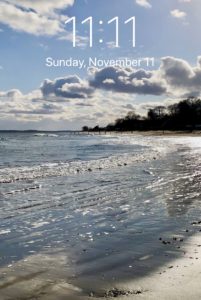
On Veteran’s Day 2018, I looked at my iPhone to check the time. It happened to read 11:11 November 11. This time oddity caught my attention. The sight of three 11s at once seemed significant. I snapped a photo of my home screen, not knowing how long until the last second of the minute would pass, and time would change.
At first glance, the 11’s reminded me of the twin towers’.
Later that afternoon, when researching Veteran’s Day, I learned “the major hostilities” of WWI on the Western Front officially ended on the 11th hour of the 11th day of November, the 11th month of the year, 100 years before, in 1918, when the Armistice of Germany went into effect and Allies of WWI and Germany signed an agreement, and hence, “Armistice Day” was created. (In 1954 the United States government re-named the honorary day to Veterans Day.)
“Wow, the time was significant!” I thought, and felt it was a sign.
The intertwining thought of Veterans Day and Germany led me to think of an important, and under appreciated, time in our country’s history and freedom – the English Revolution of 1688 and 1689, during the Boston revolt in the ‘Dominion of New England,’ which at the time included New Amsterdam (now New York City). On the night of June 2, 1689, supporters of England’s King James II were upon seizing Fort William – where official government documents and funds were held – to massacre their Dutch fellow-citizens, when an armed mob gathered to overthrow the existing government.
Crying “Leisler,” the group rushed to the New Amsterdam home of my 8x great grandfather, Captain Jacob Leisler, a German born American colonist, the son of a Calvinist French Reformed minister, who died when his son was eleven years old. After his father’s death, Jacob was sent to military school and at age eighteen, immigrated to New Amsterdam as a military captain with the Dutch West Indies Company and eventually became a self made wealthy merchant and trader.
He often aided the same people that were then asking him to take control of the city and ultimately the entire province from appointees of King James II.A sympathizer with the Dutch lower classes and poor of the province, known to pay for the freedom of slaves from Africa and/or white people arriving from elsewhere to New Amsterdam who could not afford ship fees, and purchasing the land of what is today the town of New Rochelle in order to create a settlement for Huegenot refugees, Leisler was popular. Within an hour, in possession of the keys of the fort, which had been seized. Four hundred of the new party signed an agreement to hold the fort “for the present Protestant power that reigns in England,” while ten people comprising a committee of the city freeholders assumed the powers of a provisional government, declaring Jacob Leisler in charge, commissioning him “captain of the fort” (today known as the Battery in Lower Manhattan).
Thus began the period known as ‘Leisler’s Rebellion,’ in the midst of England’s Glorious Revolution. During the time of the Rebellion, a revolt reflecting colonial resentment against King James II, Leisler called the first Inter Colonial Congress in America and brokered the largest New York land deal to date for immigrant Huguenots to settle on while Colonel Nicholas Bayard, (the sixteenth mayor of the city and a man ironically a man related to Leisler through Peter Stuyvesant), escaped the city to avoid assassination.
When an English major landed with two companies of soldiers, demanding the fort back, Leisler refused. Leisler and a group of men, including his son in law, Jacob Milborne, bearing the same first name, were arrested and imprisoned for treason and murder. When Royal authority was restored, a trial was held. Leisler and Milborne fought for their lives against judges who were political enemies under the influences of England, excessive alcohol, and ties of family, “whose acts were described as ‘inhuman and gross.’”
Before Leisler and Milborne were executed by hanging, Leisler made a long speech, stating that he acted “for the glory of the Protestant interest, the establishment of the present government, and to protect the province from outside forces.” The new government seized Leisler’s land, which he’d set up for French Huguenot refugees. That land later became the town known today as New Rochelle. In 2013 a monument of Leisler was erected there. The Leisler Institution in New Rochelle holds Leisler’s letters and memorabilia, and others pertaining to the Leisler Rebellion period. The lower part of Manhattan, “the Battery,” which Leisler also owned, was in addition confiscated by the English, later returned to his son. Posthumously, the names of Leisler and his son in law were cleared and their bodies reinterred in the Dutch Church in New York, and in the early 20th century several plays were written and played in Leisler’s name, one being “A Story of Old New York.”
Just shortly before Leisler’s Rebellion, not far away from New Amsterdam, in Hartford, Connecticut, on the night of October 31, 1687, another ancestor of mine, Captain Joseph Wadsworth, according to the legend of the Charter Oak, spirited the Royal Charter of 1662 out of Sanford’s Tavern and the hold of Sir Edmund Andros, raced across the bridge over the Little River and hid it in the hollow of an ancient oak tree on the grounds of Samuel Wyllys’ home in Hartford. To many 19th-century defenders of the legend, the hiding of the Charter was a precursor for the later, more widespread, defense of colonial rights that led to the American Revolution and independence. It is telling that Hartford, Connecticut’s residents resisted the attempt by an agent of the British crown to illegally take their rights.
Less than one hundred years later, on May 20, 1775, in opposition of England’s control, my 4th great grandfather, Joseph Vose, born and raised in Milton, Massachusetts, led a group of 60 men on a mission to burn a light house in Boston Harbor. He was later chosen Colonel of the 1st Massachusetts Regiment and became part of General George Washington’s staff, fighting beside Washington at the Battle of Yorktown.
From Williamsburg on March 25, 1781, General Marquis de Lafayette wrote Colonel Vose: “It is my wish that you have the detachment in the most perfect readiness tomorrow. Should his excellency the Commander in Chief in consequence of having heard of the British fleet send orders for the return of the despatches which will be be opened by my aid-de-camp, I desire the you will not as before directed put them in execution til further notices from me, as it’s improbable that the Commander in Chief can be acquainted with this last circumstance relative to the meetings of the fleets. I request you will present this to his Excellency, Gov’ Lee and to Commander Nicholson, the Commanding Officer of the the Reg and my two aid-de-camps. I have the honor to be your obedient servant, Lafayette.”
I was reminded, too, of how veterans, though time, inspire other generations of veterans. My 2nd great grandfather, Colonel Osgood Vose Tracy, of the 122nd New York State Volunteers, who fought in the American Civil War from 1862-1865, wrote after the Battle of the Wilderness, “At that moment, in the bloodshed and horror, fighting the enemy face to face with bayonet, sword, and rifle, less than five feet apart, I thought of my great grandfather Vose at the Battle of Yorktown, took courage and fought on.”
About the same time before the American Revolution, my 4th great grandfather, Colonel John Bayard, a delegate from Pennsylvania, who my grandfather, John Bayard Tracy, was named, was elected to the convention of Pennsylvania in July 1774, and re-elected in 1775. This group, originally the revolutionary counter to the official assembly, eventually replaced it as the legislature for the new government. When regiments were raised for the defense of Philadelphia in 1775, John became Colonel of the second regiment. In 1776, when the convention became a constitutional assembly, he was named to the Committee of Safety. In March 1777, he became a member of the state’s Board of War, and Speaker of the Pennsylvania Assembly, re-elected in 1778.
In the meantime, the law firm he co-founded, Hedge & Bayard, became one of the firms under contract with the Continental Congress to supply the Continental Army. John himself fitted out a ship sent out as a privateer. But, in the fall of 1777, the British occupied Philadelphia. Bayard moved his family to a farm at Plymouth, Pennsylvania and took to the field with his regiment, which fought at the Battles of Brandywine, Germantown, and Princeton. General Washington cited Colonel Bayard for his gallant leadership in the Battle of Princeton.
In 1781, Bayard became head of the Board of War, and joined the state’s Executive Council. Under Pennsylvania’s 1776 Constitution this was a sort of combination of the roles of a governor’s cabinet and the state Senate. In 1785 Bayard was elected to the Congress of the Confederaton, the successor of the Continental Congress. He served in 1785 and 1786, attending their meetings in New York.
In the 20th century, my grandfather, John Bayard Tracy, thankfully did not serve in wartime but like his brothers, attended Culver Military School. During WWII, his youngest brother, Marine Colonel, Charles “Ted,” Sedgwick Tracy II, saw action at Saipan, Tinian and Iwo Jimo. A quartermaster, Ted was in charge of planning and getting supplies by boat to three marine divisions, landing on dangerous beaches and foreign land. For a job well done he was awarded the Legion of Merit. I recall my Uncle Ted with only a smile on his face and zest for life. He rarely spoke of his own war ordeal yet gladly spoke of the experiences of those ancestors who fought before him.
My grandmother and grandfather’s youngest son, John Bayard Tracy Jr., a lieutenant in the U.S. Air Force, who loved to fly, would go on to give his life for our country when, while co-piloting a plane on a SAC mission back from Russia during the Cold War on February 9, 1962, it exploded, killing him and all other six men on board, their bodies never able to be recovered. I consider my Uncle John and all those on board that fateful day veterans of war and am very proud of their passion and service.
On each Veterans Day while I was growing up, I recall my parents and grandparents honoring the day, by speaking of it and bringing plants and flags to the cemetery. I have always enjoyed attending ceremonies and parades in honor of those living war veterans and those deceased. It is important for veterans to see that they are not forgotten, that their services in wartime to our country and our freedoms were not in vain. I hope that I have instilled in my three sons that whenever they see a veteran with a hat on to thank them for their service. Shake their hand. Talk to them. Get to know them and a bit about their service if they so allow.
And of course it is not only living veterans and/or those veterans killed in action that deserve recognition. It is their family – spouses, parents, children, grandchildren – and friends, affected by the sacrifice that service men and women made and make, leaving their homes, those they love and love them, and especially, of course, those that never came home.
I am grateful this Veterans Day and Thanksgiving for the generations of those veterans that fought and protected the freedoms we have today in our country and pray that the many battles of days and wars before, in both war time and that leading up to war – in fighting ground to ground, face to face, air to air – today and moving forward will be with the use of words and a shake of the hands.
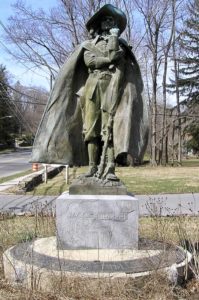
*
Veterans Reunion Speech
Congressional Medal of Honor Recipient
Brevet-Major William Gardiner Tracy
122nd New York State Volunteers
“We meet today, the veteran survivors, to commemorate the most notable events of our lives; the noblest acts of our career; to recount the dangers that we have passed; to relate our former triumphs won, and to mourn for our heroes fallen.
We have all borne our part in the heat and burden of the day of strife. We have all endured the long and weary, dusty march; we have dropped to earth almost too tired to rise again; we have shivered through the night in the cold and wet bivouac, and frequently suffered the real pangs of hunger and thirst.
To us all the sharp ring of a rebel bullet has been a familiar sound, as well as the dull and sickening thud that announced the bullet had reached its mark; the very earth has sometimes trembled under our feet from the discharges of musketry and artillery; we have known the despair of defeat and felt the blood pounding through our veins as we joined in the surging wave of victory.
Once more, sometimes as a strain of martial music strikes the ear, or a discharge of cannon is heard, a vision arises before us of other summers, of fields of yellow grain and tangled forests; once more we see the serried lines of gray and blue, we hear the shriek of the shell and the yell of the rebel charging column, and once again the tragedy of violent and immediate death of well-beloved comrades is enacted before our eyes.
We shall never cease to feel a thrill of pride so long as we continue to breathe, that in the morning of our lives, when everything was at its brightest and its best, when the dew was on the flower and the night was on the wave, when life was still “the roses hope while yet unknown,” that we were willing to sacrifice it all for the love of our common country.
That we were willing to give up the full pleasures of this world which we had just begun to experience as men, to throw down our work, to destroy the careers we had marked out for ourselves, and all for no other purpose than to preserve intact the nation that gave us birth.
Our lives were as sweet, our happiness as dear to us then as life and happiness are now to the men who walk our streets to-day, yet were we willing to surrender all, without hesitation and without scruple.”
Posted on Categories BLOG, UncategorizedLeave a comment on A Sign of Time on Veteran’s Day – Remembering, Honoring, and Gratitude